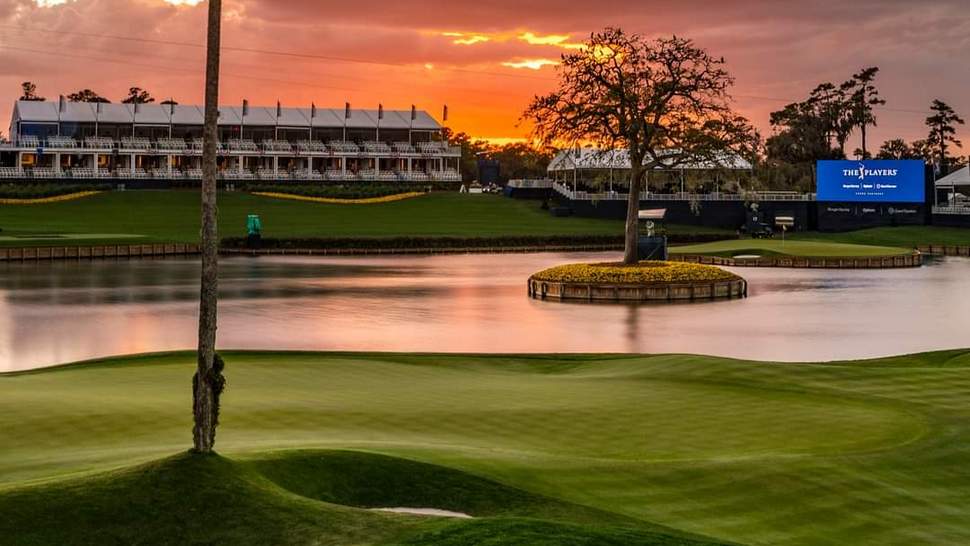Ponte Vedra, FL. This week’s Players Championship marks the 50th anniversary of the famed event being played at TPC / Sawgrass. The Players Championship was not embraced by players in its earliest days and much of that angst was directed at architect Pete Dye.
Dye envisioned a design in which no specific type of player would have an advantage. In looking at the winners over the years there is no specific type of player that has been a dominant force. Long hitters have won at times. On the flip side there have been winners such as Fred Funk and Calvin Peete who were deadly straight off the tee but hardly viewed as above average in total driver distance.
Over the years, Dye made various modifications to the course that opened in 1982. It was that same year when winner Jerry Pate pushed Dye and then PGA TOUR commissioner Deane Beman into the water off the 18th green as penalty for such a difficult course, then dove in himself.
Being the flagship event for the PGA TOUR has meant being on the cutting edge in terms of course conditioning and overall acceptance by those competing for the prestigious title.
“How this event has grown in size, scope and impact over the past five decades is something we’re extremely proud of,” said PGA TOUR Commissioner Jay Monahan. “And we continue to focus on delivering the best championship to our players, fans and partners.”
Dye passed away at 94 in 2020 but he was able to keep a close eye on his most noted design given the annual stature the event generates.

The par-72 7,275-yard layout is a virtual minefield. The annual gathering brings to the forefront a word that elite professionals despise in being humiliated – exposure.
Dye had a keen penchant for knowing how to get under-the-skin of the world’s best players. He was keenly aware of their innate abilities since Pete was a quality player in his own right. Growing up in Ohio and winning the Indiana State Amateur and then qualifying for the U.S. Open at Inverness in 1957 even though he missed the cut along with Arnold Palmer and Jack Nicklaus.
TPC / Sawgrass is a constant battle in making sound choices. There is no per se “relaxation” moment – it’s always the spiraling upwards of constant pressure meant to peel away the false sense of self-created security elite players have. In sum – you drop your guard at your peril.
This is especially true as one faces the gauntlet that makes the 16th, 17th and 18th a formidable trio. While much attention is centered on the short island par-3 17th — the combination of holes is what makes any Players Championship fraught with uncertainty. Players grappling with internal emotions – inner demons that can overwhelm any outward sense of confidence.
Dye understood better than just about any other architect the anguish of psychological warfare. Dye created a design where mental focus is imperative. As all players are aware, on any swing rounds can get derailed and valuable momentum sapped. Under benign conditions low scores have been shot with Greg Norman’s remarkable four-round record total of 264 (-24) in winning in 1994.
On the flip side there have been years when fluctuating wind patterns have played havoc and players have been whipsawed and made to look foolish. No three holes have demonstrated that element of fear better than this final trio.
16th Hole / 523 Yards / Par-5
The 16th looks on paper to be the easier of the final three holes and generally is. However, the most challenging aspect is that players looking to reach the green in two shots need to work the tee shot on a right-to-left ball flight.
For right-handed players this requirement is no easy feat. Today’s drivers and golf balls apply less spin so being able to hit a controlled ball movement to the left is no small accomplishment.
Even for those who successfully place their tee shot, the second shot presents an array of challenges. Water comes into play starting at roughly 150 yards and extends all the way to the green on the right side.
Players attempting to steer away from the water have to be ever mindful of going too far left and encountering a menacing bunker that is further complicated by a cluster of oak trees which are located within the heart of the bunker. Complicating matters even more is that the canopy of the trees grows out away from the bunker and only serves to narrow the landing strip leading into the green.
The 16th provides an opportunity for an eagle and birdies are generally plentiful. However, such scores can be tempered when rash execution leads to head scratching moments.
17th Hole / 137 Yards / Par-3
Arguably, the most famous or infamous hole on the planet. The penultimate hole is the quintessential example of total exposure. And no one knows that better than each of the competitors who arrive there each round.
With thousands engulfing the green the spectacle of pressure can be overwhelming for many. In last year’s event Chad Ramey held a two-stroke lead when he arrived at 17 on Friday and carded a quadruple bogey 7 to drop the top spot.
Yet the hole proved benign just one round later when round 3 yielded a 2.72 average – the second-easiest day since 1983.
58 balls were hit into the water in 2023. The all-time record (since that stat started being kept in 2003) is 93 in 2007. The overall total since 2003 stands at 990 entering this week’s championship.
Over the years there have been 13 aces made at 17. None happened from 2003-15 but a total of seven took place in the last six tournaments including three in 2023. Last year marked the first time there were multiple holes-in-one on 17 in the same tournament.
What is amazing is that the shot is nothing more than wedge for nearly all players unless wind conditions really arise. 50 is the most balls hit into the water during a round. That came in the first round in 2007. During last year’s second round no less than 25 balls found the water.
Given the shortness of the hole the execution in hitting the target from the tee has ranged a good bit. In 2022, only 65.96% hit the green in the regulation stroke. The highest rate came in 2014 when the field found the putting surface with a remarkable 86.79% clip.
Pin placements set the tone at the 17th. In the early rounds a frontal pin location can be a test of nerve in determining how much yardage is needed to get beyond the water. There have been players who have hit the green and back spun into the water. Then there was the sensational birdie putt made by Tiger Woods in winning the 2001 event. NBC-golf analyst Gary Koch kept repeating “better than most” as the 60-foot triple-breaking downhill putt tumbled into the hole.
The Sunday pin placement is one that causes the most heart palpitations. When placed in the far-right corner players must negotiate a solitary small bunker that awaits those failing to hit enough club.
For those who fly the bunker the tee shot must land softly into the tiniest of spaces. Players who meekly avoid the risk are not assured a par because the green contours often inflict a quick three-putt for those unable to summon the nerves when called upon.
The most sensational of scoring efforts came from 2015 champion Rickie Fowler. He birdied the 17th no less than five times during the week – three of which came on the final day – including two in a playoff to snare his biggest professional win to date.
18th Hole / 462 Yards / Par-4
Just to make matters more interesting the final hole at TPC / Sawgrass provides the ultimate crescendo of pressure.
Among the most difficult holes faced when players arrive at the final hole the landing area for tee shots seems acutely narrow with the hole turning left with water lurking on that side for the duration of the hole.
It is a daunting task to retain composure knowing full well what kind of pushback can happen with the slightest of errors.
Like the 16th, the ideal tee shot at the 18th is working the ball on a right-to-left ball flight and following the land as it turns in the drive zone. That can be easier said than done.
Players who have failed to start the ball over land can face the daunting task of having to hit their third shot from the teeing area.
The bend of the fairway provides different options. Many chose a preferred safer play in hitting less than driver to the right. Those going this route have to be mindful that the fairway does end at roughly 280 yards before encountering trees located in that area.
Aggressive tee shots can reap significant rewards provided they stay on dry land.
The approach is also no bargain. A series of mounds and rough are located to the right of the green.
Often times the final round pin position is located in the far rear left corner nearest to the water. Players then have to decide how aggressive an execution they are willing to take. Those coming up way short are left with a testing two-putt. Those erring long face a nearly impossible recovery for par.

Related: The Dyes legacy — Pete and Alice — lives on
***
Dye’s genius meant having multiple situations where exposure / fear is there to overcome. Some players rise to that occasion – others are consumed by it.
The finishing three holes at TPC / Sawgrass provide a final test of nerve and skill. A high-wire act with no safety net below.
One can only imagine Pete smiling and reveling at the exquisite torture chamber he so magnificently put into motion.
How ironic the final three holes provide a fitting climatic platform where either you —
Do or Dye.

